South Carolina’s Greenville Health System Swamp Rabbit Trail

Trail of the Month: February 2016
“It has really been an economic boon, not just to Greenville and Travelers Rest, but to the whole county.”
At the doorstep to the Blue Ridge Mountains of South Carolina, the Swamp Rabbit Trail has become so integrated into the culture of its trailside towns that its iconic rabbit has become the mascot for the entire community. Many of the local businesses include a nod to the Swamp Rabbit Trail in their name; visitors will find a Swamp Rabbit Café, Swamp Rabbit Brewery and Swamp Rabbit Inn among others. Even Greenville’s minor league hockey team, formerly called the Road Warriors, changed its name in 2015 to the Swamp Rabbits, swapping a long-held car moniker for a trail-centric one; their new slogan: Fear the Ears.
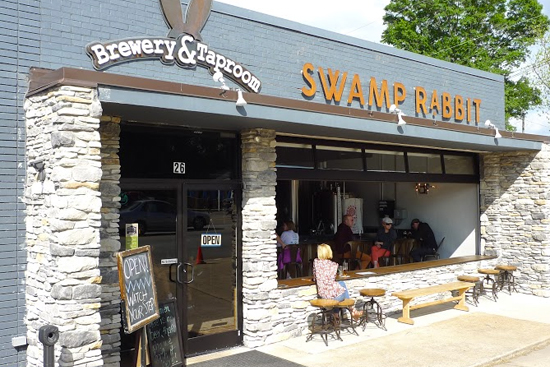
“Businesses have formed up and down on it,” says Carlton Owen, a Greenville resident and former board chair of the land conservation group Upstate Forever, who played a leading role in the trail’s development. “It’s been one of the engines of economic development in the community.”
It’s not hard to see why locals are so passionate about the trail, which is officially known as the GHS Swamp Rabbit Trail after its largest corporate sponsor, the Greenville Health System. (Where it got its memorable rabbit moniker is up for debate, though some say it was the nickname of the trains that rumbled through here in the late 1880s.) Weaving just over 15 miles through the vibrant heart of Greenville to the quaint community of Travelers Rest, the paved pathway is a showcase for what the region has to offer.
Along the way, it travels through some of the area’s most picturesque parks—the waterfalls at Falls Park and its stunning suspension bridge should not be missed—as well as the Furman University campus, widely regarded as one of the most beautiful campuses in the nation. Lined with big, shady trees and following the Reedy River for much of its journey, the trail is for those who want a town and country experience, enjoying nature with all the charms of civilization—restaurants, shops and attractions—close at hand.
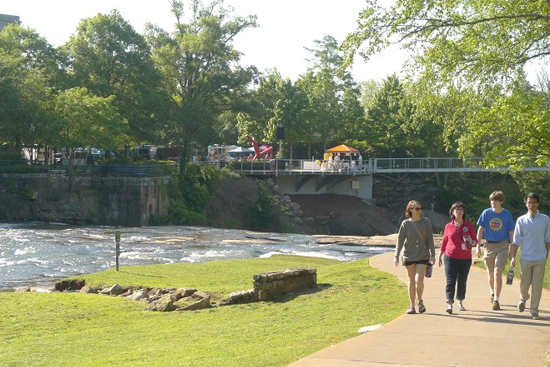
“Every day of the week, it doesn’t matter the time of day or the season, there are people on the trail,” says Dianna Turner, the city administrator for Travelers Rest.
Another section of the trail, unfortunately disconnected from the main spine, is perhaps one of its most scenic, winding nearly 4 miles through Lake Conestee Nature Park, a 400-acre natural oasis of forest, wetlands and wildlife habitat.
The Bunny Boom
“It was just a sleepy little place,” says Joyce McCarrell about Travelers Rest, her hometown and site of the Café at Williams Hardware, a restaurant she co-owns with her sister. “There were a lot of empty buildings along Main Street. There was nothing to spur people’s imagination or interest in town.”
Before the trail’s arrival, most traffic simply sped past on a four-lane highway through town, not stopping at local businesses. McCarrell recalls the only eateries in town being a fast-food joint and a Chinese restaurant. By the mid-2000s, articles about the project were appearing in the local papers, and a ‘low buzz about the trail’ was spreading in the community, according to McCarrell, but many thought that nobody would ride it. “It was a ‘Field of Dreams’ idea,” she says. “If you build it, they will come.”
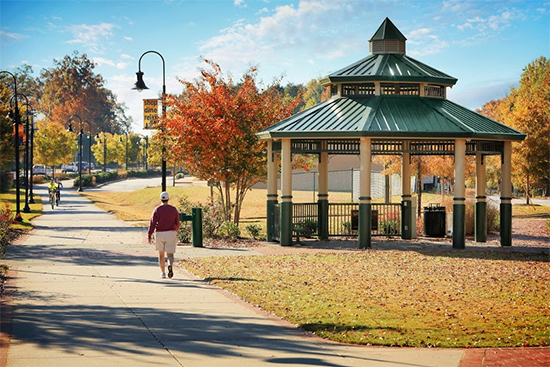
Although McCarrell and her sister Nancy weren’t entrepreneurs—one had been a lawyer and retail store manager, and the other a manager in a medical office—nor even avid bike riders, there was something about the idea of the trail that resonated, and they wanted to be part of their hometown’s revitalization. Thinking about the practical needs of trail goers, the sisters realized that there was no easy place in Travelers Rest for people to use the restroom or get a bottle of water and snacks, so their original idea was to open a snack bar with an employee or two.
The idea quickly evolved into a place where people could get “good food, done fast,” and today, their restaurant—with its homespun charm and a staff of 20 (more during peak times)—is a popular stop, primarily serving soups, sandwiches and salads with a pocket park out back and a porch overlooking the trail for al fresco dining. They opened in late 2008, just before the Swamp Rabbit did, and it was a watershed moment. Travelers Rest now supports an eclectic mix of nearly a dozen restaurants offering everything from crepes to sushi. So many businesses now populate the entire trail that a quarterly food guide humorously called “The Carrot” maps out those within a mile of the pathway.
“It has really been an economic boon, not just to Greenville and Travelers Rest, but to the whole county,” says McCarrell, who regularly sees tourists come from nearby Atlanta and Charlotte, as well as farther afield.
Clear the Hare
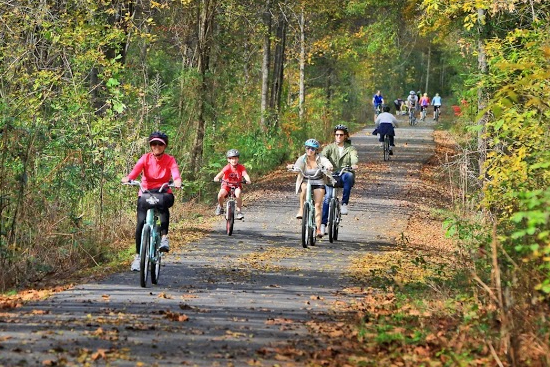
Greenville County had purchased the abandoned railroad corridor in 1999, and by 2005, the project was ready to get into full swing. To get the public and community leaders excited about the trail and see its potential, Owen recruited a volunteer labor force. The project kicked off auspiciously with 200 helpers one bright Saturday morning.
“It was really a grassroots effort,” says Turner, who was among the first wave of volunteers. “Once that momentum started going, you just couldn’t stop it.”
Judy Cromwell was just a wisp of a thing out there clearing the tangle of gnarly brush that had overtaken the old rail corridor; her small, gray-haired frame perhaps diminished further by its proximity to the dozen or so much larger men in prisoners’ uniforms beside her. Citizen volunteers and a group of low-risk prisoners who had signed up for the duty worked steadfastly side by side in the unrelenting heat—it was one of the area’s hottest summers on record—and, over the course of many weeks, a pathway began to take shape.
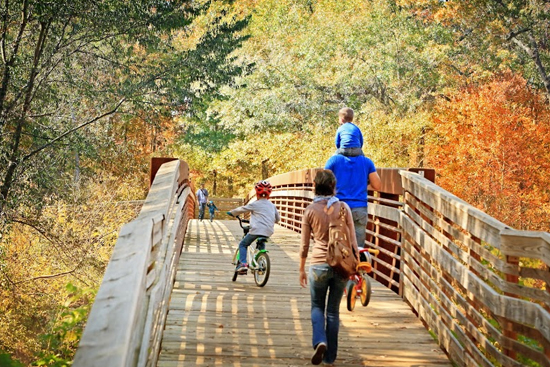
“Sometimes we’d get not even 50 yards each day because it was so grown up with woods and trees,” recalls Cromwell. “But I liked sawing and whacking away.” The vegetation was so thick that she recounts the experience as “making a little hole in the wall” with each outing.
“One day, Judy arrives and she’s dressed exactly like the prisoners,” says Owen of his most dedicated volunteer whom the prisoners affectionately called Ms. Judy. “They wore light blue shirts and dark blue pants, and when I asked her why she did it, she said, ‘I didn’t want them to feel different than the rest of us.’”
The Saturdays rolled by, and as the task of removing two decades of growth became increasingly daunting, by about three months, the numbers had dwindled to just Owen, the prisoners and the tenacious Ms. Judy.
A Health Hop-portunity
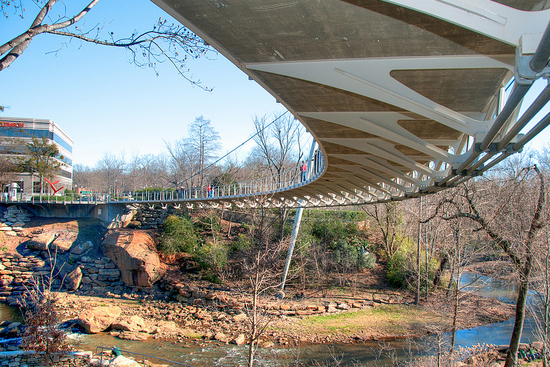
When the county pulled up and sold the rails in 2007, the proceeds covered the expenses of an earlier legal battle over the corridor. The case was eventually won by the county and trail advocates, but new sources of funding were needed to keep the trail effort going.
“We needed a partner, so I thought, ‘Let’s go to one of the big hospitals and pitch it to them,’” says Owen of a meeting with the Greenville Health System (GHS), one of the largest healthcare networks in the Southeast. “We told them that it was going to be a phenomenal asset and it would be great to have their name tied to something that keeps people healthy.”
GHS was immediately enthusiastic about the project and provided a sponsorship of $100,000 a year for 10 years primarily to help market the trail and promote its use for physical activity.
“It clicked, it made sense,” says Rebecca Cooper, GHS community and customer relations coordinator. “And we had the leadership that recognized the impact on the community.”
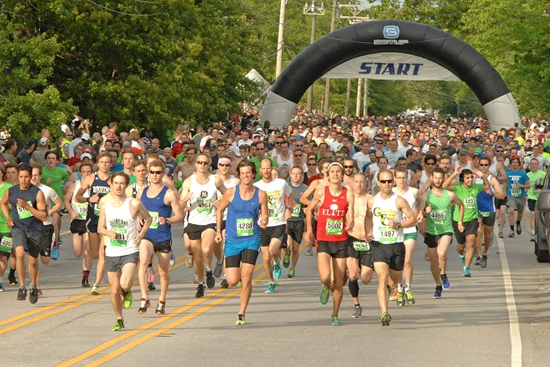
By 2009, the first 5-mile section of the trail was complete, stretching from south of Furman University through Travelers Rest, and a grand opening in tandem with a 5K run hosted by GHS took place that May.
“Travelers Rest is a small town with 5,000 residents, so we figured it would be a small ribbon-cutting,” says Ty Houck, director of greenways for Greenville County. “But we doubled the population of the town because so many people showed up.”
The run, originally planned for the 10-foot-wide trail, swelled so large that it spilled over onto two lanes of the adjacent highway, and the GHS Swamp Rabbit 5K continues to be a hugely popular event to this day.
Can’t Stop the Hop
“Demand for the trail is strong,” says Houck referring to annual trail counts taken since the Swamp Rabbit opened. “Each year, it was a double digit increase.” The most recently published data pegs the count at more than 500,000 users a year.
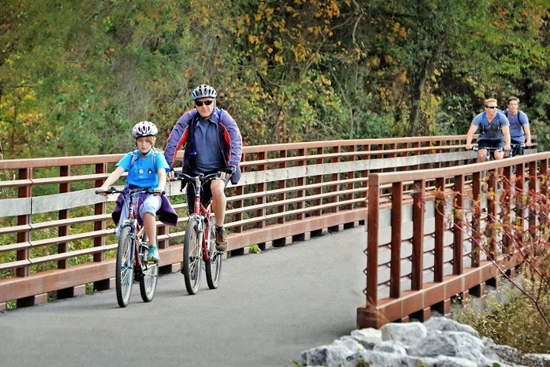
“The thing that has amazed me from the beginning is how many different types of people I see using the trail,” says McCarrell. “I see the power walkers and the older couples who stroll hand-in-hand, people of all ages on all kinds of bikes—it’s just amazing the variety of users I have seen on the trail. That’s what has pleased me the most. It’s an everything trail.”
Not resting on its hunches, the Swamp Rabbit is on the move. The surrounding communities have seen what the trail can do and are clamoring for a connection to it. Plans are afoot to expand the GHS Swamp Rabbit Trail north to Slater-Marietta and south to the communities of Mauldin, Simpsonville and Fountain Inn. The latter even has its own small piece of trail in place already, waiting in the wings for the linkage to the larger whole. Neighboring Laurens County is forming a master plan to bring the trail into their communities, and Pickens County, inspired by the Swamp Rabbit, recently completed their own rail-trail project in the summer of 2015.
“Pickens and Easley, two small towns west of us, were so enamored by it that they implemented their own rail-trail to tie those two towns together,” says Owen of the 7.3-mile Doodle Rail Trail.
The impact of the Swamp Rabbit on the community has been wide-ranging, spurring new connections in the county for health, economic prosperity and environmental stewardship. But for Houck, like many residents, the impact the trail has had on his life—and his family’s life—has also been uniquely personal. “My favorite thing about the trail is that I live 1,200 feet from it,” chuckles the father of a 7- and 10-year old. “My kids will bike to the movies and bike to dinner. I’ll get a family group text, ‘Pedal to pizza?’ and we’ll meet up and caravan up to Main Street via the trail.”

Donate
Everyone deserves access to safe ways to walk, bike, and be active outdoors.



